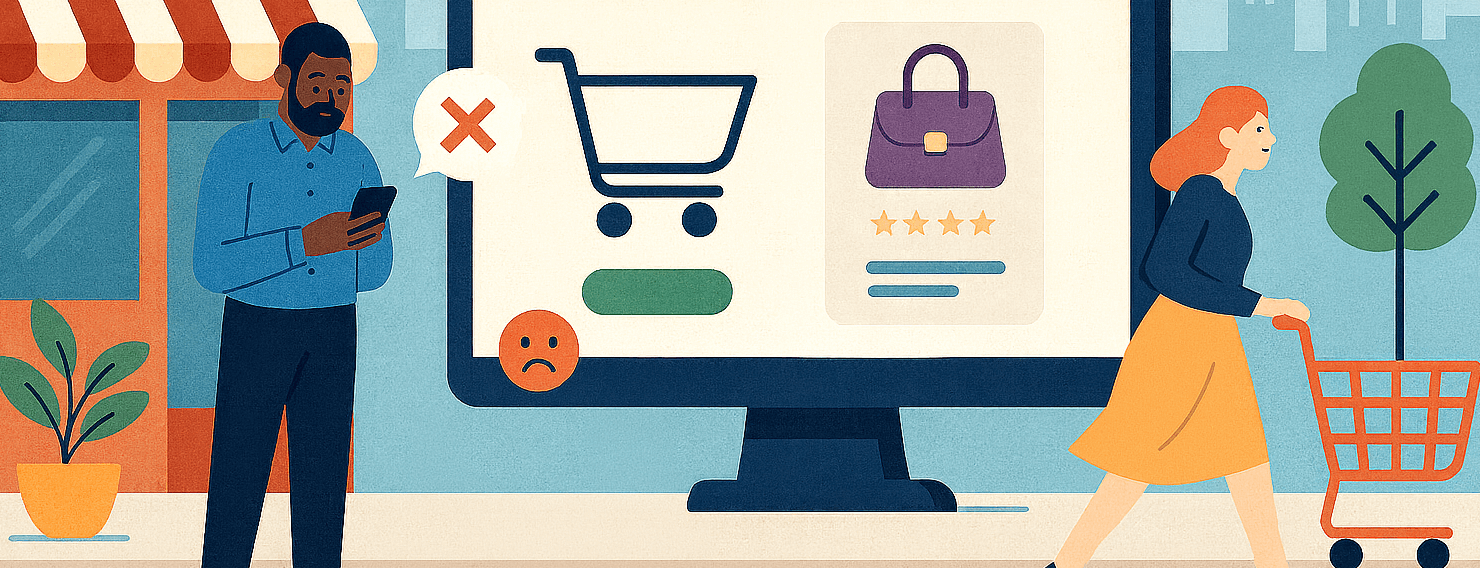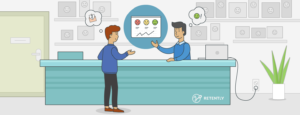Table of Contents
- Key Takeaways
- Why UX is the Silent Driver of Customer Satisfaction
- The Psychology Behind Good (and Bad) UX
- Bad UX Examples You’re Probably Guilty Of
- Checkout UX Mistakes That Kill Conversions
- The Post-Purchase Experience: Where UX Still Matters
- Measuring the UX Impact on Customer Satisfaction
- Turning UX Mistakes into Wins
- Future-Proofing Your UX
- Conclusion
We’ve all been there – ready to buy, credit card in hand – only to rage-quit a website because the page took forever to load, the checkout looked like a tax form, or pop-ups jumped out from every corner. Frustrating? Absolutely. And for online stores, those moments can be the kiss of death for a sale.
A great user experience blends good looks with effortless navigation, making every step from browsing to checkout feel natural and stress-free. When shopping feels easy, customers stick around, complete their purchase, and are happy to return. When it’s clunky or confusing, they vanish, often straight to a competitor.
In this guide, we’ll dig into common mistakes that quietly drive shoppers away and show you how to turn them into satisfaction-boosting wins.
Key Takeaways
- Minor issues = major losses. Don’t ignore small friction points; they’re often silent deal-breakers.
- Checkout is where sales die. Remove forced sign-ups, offer multiple payment options, including Klarna systems (Buy Now, Pay Later), and avoid last-minute cost surprises.
- Bad UX kills loyalty quietly. Customers rarely complain; they just leave.
- Measure everything. Use CX surveys to see what’s working and what’s not.
- Design for ease, build for growth. Clear navigation, mobile-first layouts, and transparent pricing win repeat business.
Why UX is the Silent Driver of Customer Satisfaction
In ecommerce, customers rarely notice good UX because it quietly does its job. Pages load quickly, products are easy to find, checkout is painless, and updates arrive exactly when they’re needed. Everything feels smooth, and that seamless flow builds trust without the shopper even realizing it.
Bad UX, on the other hand, demands attention for all the wrong reasons. A clunky layout or confusing process instantly chips away at confidence, making buyers second-guess their purchase or leave altogether.
The numbers tell the story: Forrester research shows that a well-designed UX can increase conversion rates by up to 200%, while reducing effort at key steps dramatically boosts retention. That’s where Customer Effort Score comes in.
Think of CES as a “how hard was that?” meter. Imagine a return process where you simply click a link in your order history, choose a reason, and get an instant label, versus one that makes you call support, dig through order numbers, and wait for an email. The first scores high on CES, leaves customers satisfied, and strengthens loyalty. The second? It’s a fast track to frustration and churn.
The Psychology Behind Good (and Bad) UX
Behind every click, scroll, and tap is a shopper’s brain working to process information and the more you pile on, the harder it works. This is where cognitive load comes in. When a website throws too many choices, too much text, or too many competing visuals at a user, it creates decision fatigue. The result? Slower decisions, abandoned carts, and a sense that shopping is just… exhausting.
That’s why, less really does feel like more. Clean layouts, clear calls-to-action, and simple navigation help shoppers focus on what matters, finding what they want and checking out without friction.
The difference between good and bad UX often comes down to guidance vs. clutter. Helpful guidance is a subtle filter suggestion or a “best sellers” shortcut that feels like a tip from a friend. Overwhelming clutter is a wall of flashing banners, endless pop-ups, and multiple conflicting CTAs all screaming for attention. One clears the path. The other clogs it.
Bad UX Examples You’re Probably Guilty Of
Sometimes the biggest UX killers aren’t dramatic design disasters, they’re the everyday annoyances that quietly drive customers away.
- Slow-loading product pages: Nothing kills shopping momentum faster. Even a two-second delay can spike bounce rates and tank conversions. Users expect instant results, and if they don’t get them, they’ll head to a competitor who can deliver.
- Navigation that buries popular categories: If your best-selling products are three clicks deep, you’re making shoppers work too hard. Usability studies consistently show that customers abandon searches when they can’t quickly find the category they had in mind.
- Inconsistent design language: A smooth desktop experience doesn’t guarantee a smooth mobile one. When buttons shift, menus change, or layouts break, it forces users to relearn your store on each device- frustration they won’t forget.
- Pop-up overload and intrusive modals: One well-timed pop-up can be helpful. Four in a row before a user even scrolls? That’s a fast track to an angry “close tab.” Research from Nielsen Norman Group shows that aggressive interruptions erode trust and make users feel manipulated.
These bad UX examples might seem small in isolation, but together they add up to a clunky, high-effort experience, the kind that kills satisfaction and conversions.
Checkout UX Mistakes That Kill Conversions
You’ve done the hard work – your customer has browsed, picked products, and is ready to buy. Then the checkout experience throws a wrench in everything. This is where too many ecommerce sites lose the sale.
- Forcing account creation before checkout: Nothing says “buy from us later… maybe” like making someone sign up when they’re trying to pay. Many shoppers abandon at this step, especially first-time buyers who just want a quick transaction.
- Overcomplicated multi-step processes: Five screens, multiple forms, and endless required fields? It’s like making customers run a mini-marathon before they can give you their money.
- No guest checkout or limited payment options: Some shoppers don’t want an account. Others want to pay with Apple Pay, PayPal, or other quick methods (like Klarna systems – Buy Now, Pay Later). Limiting choices limits conversions.
- Hiding shipping/duty costs until the last step: It’s one of the fastest ways to cause cart abandonment. Customers hate surprises, especially expensive ones, right before they click “Place Order.”
These checkout UX mistakes all create friction, and friction is the enemy of satisfaction. Research from the Baymard Institute shows that nearly 70% of online shopping carts are abandoned, with many drop-offs happening in the final steps. A smoother checkout isn’t just nicer, it directly translates to more completed sales and happier customers.
The Post-Purchase Experience: Where UX Still Matters
Many brands treat checkout as the finish line, but for customers, it’s only halftime. What happens after the payment clears can make or break the relationship.
Smooth order tracking builds trust. Clear, timely delivery updates keep excitement high. Easy, transparent returns show you respect your customers’ time and money. When these touchpoints are effortless, customers walk away satisfied and often more loyal than they were before they bought.
But get them wrong, and all that goodwill vanishes. A confusing return policy buried in fine print? Frustrating. Tracking pages that aren’t mobile-friendly? Annoying. Missing or delayed status updates? That’s when customers start reaching out to support or worse, venting publicly.
Customers often remember the “last touch” far more vividly than the first click. That means the post-purchase UX isn’t just a nice add-on, it’s your final chance to confirm you’re worth buying from again.
Measuring the UX Impact on Customer Satisfaction
If you can’t measure it, you can’t improve it and UX is no exception. The good news? There are plenty of ways to see exactly how your experience is landing with customers.
Start with the basics: CES (Customer Effort Score) tells you how easy or painful it was for someone to complete a task, like finding a product or making a return. CSAT (Customer Satisfaction Score) captures how happy they felt afterward. NPS (Net Promoter Score) will tell you how likely shoppers are to recommend your online store based on their check-out interaction. Add in post-session feedback forms for quick, in-the-moment insights while the experience is still fresh.
On the behavioral side, session replays and heatmaps let you watch where users click, scroll, hesitate, or drop off. You might spot patterns – like customers abandoning carts after hitting a specific form field – that numbers alone wouldn’t reveal.
For example, a quick post-checkout survey might uncover that shoppers aren’t completing purchases because shipping fees appear too late in the process. With that insight, you can fix the issue before it costs you more sales.
Done right, measuring UX is about finding those friction points and turning them into satisfaction-boosting wins.
Turning UX Mistakes into Wins
The beauty of UX is that you don’t always need a full redesign to make a big difference. Often, a few small, well-placed tweaks can transform the shopping experience.
Start with best practices for ecommerce UX that keep things clean, consistent, and easy to navigate. Think clear hierarchy, mobile-friendly layouts, and buttons that actually look clickable. Avoid the temptation to cram in every feature, good design guides the shopper without overwhelming them.
Look for small, high-impact changes:
- Adding a progress bar in checkout to show customers exactly how many steps remain.
- Implementing predictive search so results appear as users type.
- Displaying real-time stock levels to create urgency without hard-selling.
The key is to identify the moments where customers get stuck or hesitate and then remove that friction. When the path feels smooth, satisfaction (and sales) naturally follow.
Future-Proofing Your UX
Great UX is something you evolve as customer expectations, technology, and buying habits change.
Start by making accessibility and inclusive design non-negotiable. Features like alt text for images, clear color contrast, and keyboard navigation aren’t just compliance checkboxes – they open your store to more customers and signal that you value everyone’s experience.
Next, embrace personalization that feels helpful, not creepy. Use browsing history and preferences to make shopping smoother, but keep it transparent and give users control. A well-timed “You might like this” can feel like a thoughtful tip; a hyper-specific suggestion that makes people wonder if you’re spying on them? Not so much.
Finally, leverage AI-assisted UX testing for rapid iteration. From running automated usability tests to analyzing heatmaps at scale, AI can help you spot friction points and test fixes faster. This way, your store stays ahead of trends and customer needs, without waiting for quarterly redesigns to make changes.
Conclusion
The best ecommerce UX often goes unnoticed and that’s exactly the point. When every click feels natural, pages load without delay, and checkout is smooth, customers simply enjoy the experience and move on with their day. But bad UX? That’s unforgettable for all the wrong reasons. It frustrates shoppers, erodes trust, and sends them straight to a competitor.
If you want happier customers and higher conversions, now’s the time to take a hard look at your store. Audit your UX flows from the first homepage visit to the last post-purchase email. Find the friction, fix the silent conversion killers, and keep testing.
Because in ecommerce, great UX doesn’t just make shopping easier, it turns casual browsers into loyal customers who can’t wait to come back.


































 Christina Sol
Christina Sol 




 Greg Raileanu
Greg Raileanu 